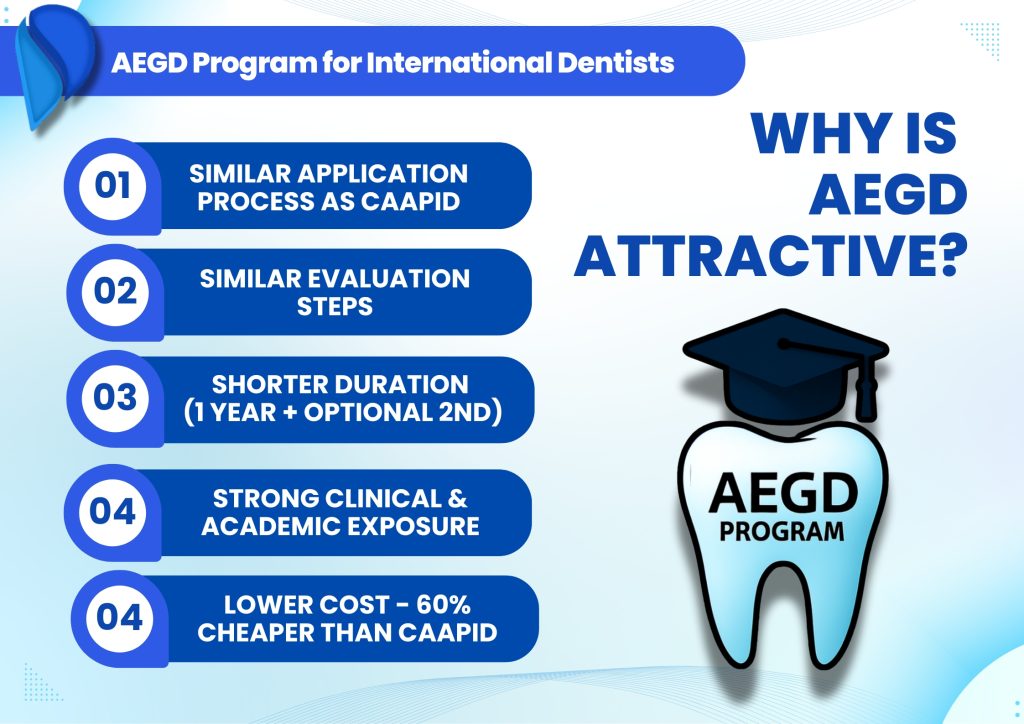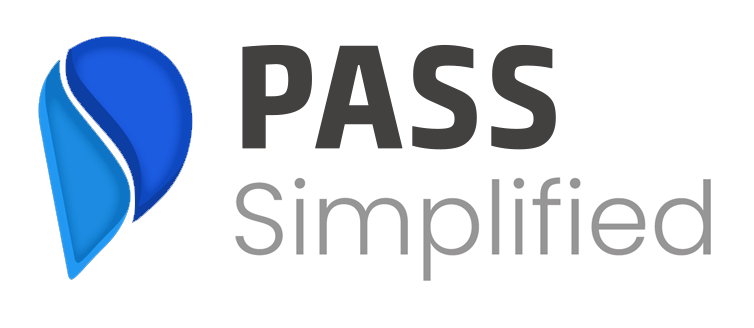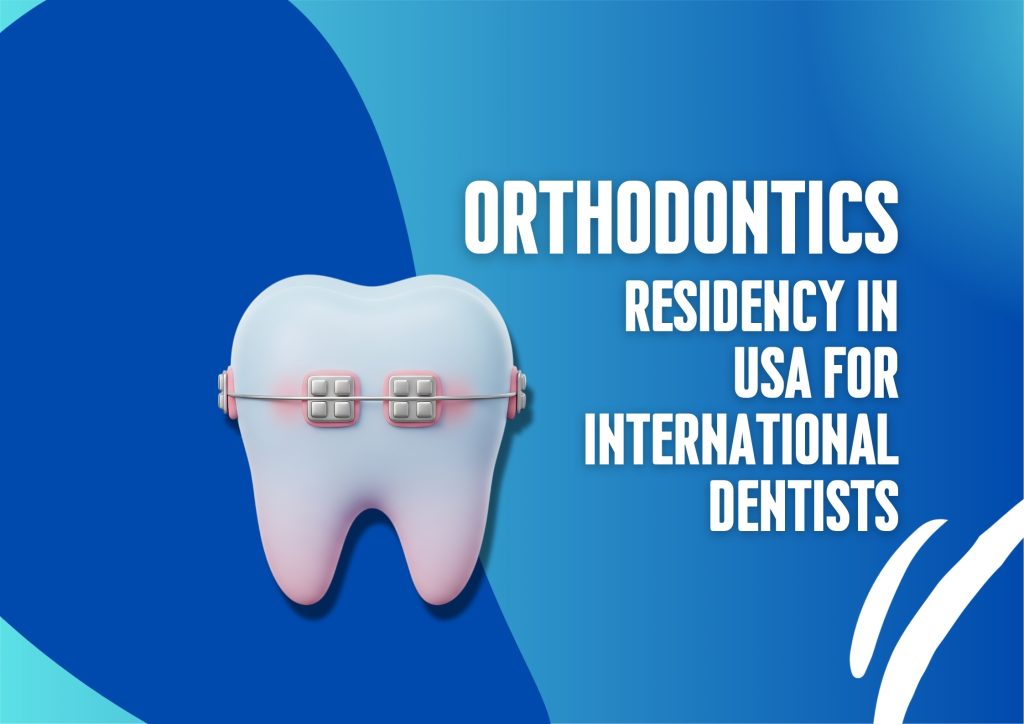Advanced Education in General Dentistry (AEGD) has been living in the shadows for quite some time. Most International Dentists who call on us assume at first that CAAPID is the only way they can secure licensure to practice in the US as a dentist.
Not true!
The Advanced Standing Programs (commonly referred to as the CAAPID process), which offer a DDS or DMD degree, are only one among six potential pathways to obtain a license in the US.
A postdoctoral program (aka “residency”) is probably the second most popular route opted by International Dentists to eventually practice in America. Among all the residencies out there, the AEGD has been particularly attractive for those who are foreign-trained.
But why?
Table of Contents
ToggleAEGD Brief Summary –
- Similar application process to CAAPID and PASS AEGD.
- Similar evaluation steps between CAAPID and PASS AEGD.
- Shorter duration: AEGD programs are typically one year shorter than Advanced Standing programs offered through CAAPID. The 2nd year in AEGD programs is usually on an opt-in basis.
- Academic exposure: AEGD program, arguably, in some schools, provides access to the same faculty and clinical resources as the Advanced Standing Programs.
- Job flexibility: Access to similar job opportunities in the state where your school is. If you wanted to move states for work, AEGD programs aren’t a good option.
- Lower cost! Dental program fees don’t follow any linear regression, and clearly, no one knows why an AEGD program is on average 60% lower than the CAAPID program fees at the same schools.

I probably know what you’re thinking right now! Why are so many things in favor of the AEGD program, and yet most International Applicants continue to apply to CAAPID ones?
Before I share that, let me quickly clarify the alphabet soup if you’re unfamiliar –
CAAPID (Common Application for International Dentists) is a portal through which dentists who completed their dental education in a country outside the US can apply to come here. These dentists get referred to by different names like “foreign-trained dentists”, “international dentists”, “immigrant dentists,” etc. The program that you can apply to through CAAPID is either called an International Dental Program (IDP) or an Advanced Standing Program (ASP), both of which give you direct access to the final 2 years of American DDS/DMD programs. The DDS (Doctor of Dental Surgery) and DMD (Doctor of Dental Medicine) are degrees conferred when you finish four years of dental school in the US, and become eligible to start practicing. The PASS portal is analogous to CAAPID, but offers access to all of America’s dental residency programs, AEGD being one among them. When you complete AEGD, you are issued a certificate as opposed to a degree.
Hopefully, that helps you get the full context of what we’re discussing here.
Key Differences between AEGD and IDP Programs
- An AEGD offers a certificate, as opposed to an IDP program that provides a degree
- If you have the right immigration status to start a practice, then securing a health professional loan would be harder with an AEGD certificate
- AEGD programs sometimes have an optional second year, as compared to more rigid durations in an IDP program
- AEGD programs limit your geographic flexibility in finding a job. Let’s discuss this last point in great detail in our following paragraph
Why is the restrictive job covenant an important consideration for international dentists?
The vast majority of International Dentists graduating from an AEGD program complete the course on a visa (i.e., F1 or J1 visa). U.S. employers, especially private practice owners, tend to prefer students who do not require visa sponsorship for work authorization, given the extra paperwork and legal fees involved. International dentists are then limited to remote opportunities away from urban centers, and within clinics run by FQHCs and DSO-like corporate chains.
A limited dental license is granted to dentists who are required by certain states to obtain work authorization for those who take on teaching roles or work at government-run dental facilities. While this license is restrictive in terms of where it allows you to practice, both institutionally and geographically, it is beneficial for those seeking job security and a reduced student loan burden.
As of 2023, there are twelve states that specify the training requirements a dentist must complete to get a license there and allow you to obtain one immediately after a residency program. This means licensure is NOT granted through reciprocity in these states. Those states are listed below –
The states categorize their licensure process into either of two paths: initial licensure or specialty licensure. After completing the program requirements, you may be eligible to apply for licensure in a subset of these 12 states.
Even though you start working in one state, you could apply to work in a different U.S. state after 3 to 5 years. This process is called reciprocity, or in simple terms, the understanding that clinical competence demonstrated in one state reciprocally proves your ability to work in a new one. You will have to study each state’s reciprocal laws to confirm what works for you.
List of programs offering an AEGD, arranged by state (Source)
You’ll note that the vast majority of programs are offered by just one institutions and are prevalent across states – NYU Langone. Here is a map indicating NYU’s AEGD presence

What must you hope to learn in an AEGD program?
These quadrants outline the typical curriculum arc of an AEGD program. At the outset, you will develop expertise in your clinical and patient management skills through –
- Providing services directly for specialized unmet needs.
- Work in multidisciplinary and both preventative/emergency settings.
- Focus on health promotion and disease prevention.
Quadrants
Clinical Competence | Interdisciplinary Care | Evidence-based care | Community Engagement |
You will treat a range of patients’ needs, including restorative, endodontics, removable prosthodontics, fixed prosthodontics, implants, oral surgery, and periodontics. You will also treat both complex patients and patients with special healthcare needs. | You will successfully work with physicians, nurse practitioners, and nurses to coordinate patient-centered care. You will further coordinate with social workers and behavioral health specialists at affiliated community health centers. | You will critically evaluate dental and medical literature and apply evidence-based care in clinical activities. You will inculcate a high standard for professional ethics and cultural humility/competence in clinical activities. | You will work with health center staff and community members to plan, develop, and implement service activities that are appropriate and relevant to community needs. You will need to adapt to the cultural context and sensitivities of the local population. |
Why should foreign-trained dentists study AEGD?
- American Lens: You will begin visualizing and training in nuanced ways American institutions provide comprehensive care, including how they use data to develop a sound diagnosis, then plan treatment before delivering it
- Consumer perspective: You will earn first-hand exposure to the clinical, social, and behavioral needs of patients. Insurance coverage often complicates how patients’ needs get presented, and providers are constrained in the range of treatment options they can use.
- Amp us exposure: You can definitely expect a knowledge update on ambulatory technology, workflow software, diagnostic AI, dental materials, and implant workflow. Multidisciplinary and hospital-based dental care operates with very different constraints than traditional dental clinics can expose you to.
- Bridge course: Because of the massive availability in options, an AEGD program can be a low-friction entry-point into US dentistry, and you could use that first step and credibility to then apply to a formal residency (like endodontics or pediatric dentistry).
Application Instructions for International Dentists
Dentists who hold a BDS, DMD, or DDS from a foreign dental school can apply for AEGD programs in the US. Most foreign dental schools are not CODA-certified, but having your degree from a CODA-certified school can open up more program opportunities for you.
- Apply through the ADEA PASS Program, and submit a non-refundable application fee.
- Must submit supplemental answers often directly to schools.
- Non-Match. You will be notified if you’ve been admitted directly by the school.
- Sometimes a 2-year AEGD program comes attached with an MS in Oral Sciences.
- Submit required documents, including Official Transcripts, TOEFL score, INBDE exam results, ECE or WES GPA, Letters of Evaluation, Resume and Personal Statement, proof of home-country dental license, and passport picture.
- Some AEGD programs may require additional supporting materials, such as a criminal background check, immunization records, or a health statement.
There are three additional considerations for foreign-trained dentists when applying to an AEGD program.
Visa Options
If you do not have a Permanent Resident Status or US Citizenship, you probably will have to choose one of the following three visa options –
- F-1 Student Visa: You would be one among 82% of students applying to AEGD programs with this visa. It allows students to stay in the U.S. for the duration of the program and work on campus for up to 20 hours per week.
- J-1 Exchange Visitor Visa: This visa is for students participating in educational and cultural exchange programs, including research and training programs such as AEGD.
- The complication is that the J-1 visa mandates a return to your home country for at least two years after completing your program.
- There are some workarounds, as mentioned here on the USCIS site, which you can use to apply for a waiver to their mandatory foreign rotation.
- H4 Visa: If your spouse is on an H1B visa, then you may be eligible to study on a dependent visa. This might be a little risky if your spouse’s H1B re-election cycle comes midway between your program and before you’ve applied and secured a job.
Program Fees
According to the ADA, the average tuition and fees for a one-year AEGD program in the 2020-2021 academic year were $57,723 for residents and $85,230 for non-residents. The typical program for foreign-trained dentists ranges between $20k and $100k for only tuition and other academic expenses.
If you live on a student budget, you should be able to manage living on a budget of $1500 – $2500 per month, depending on which city your program is based in. Student loans aren’t cheap with Federal Interest rates rising, and until there is another quantitative easing, you might want to spend less.
Competition
Out of 87 institutions offering an AEGD program each, we have about 939 total seats available according to ADA from statistics published after the academic year 2021-2022. Here is the racial and demographic split.
Assuming that most international applicants identify as either Asian or Hispanic, we estimate that they could represent more than 40% of the admitted student pool. The competition to get into AEGD programs comes from both other foreign-trained dentists and local students who’ve completed a DMD or DDS degree equivalent.
| White | Black | Hispanic or Latino | Other | Asian | 2 or more races | Non-resident alien | Unknown | |
| Female (505) | 193 | 38 | 123 | 3 | 84 | 16 | 4 | 6 |
| Male (404) | 240 | 20 | 60 | 2 | 123 | 13 | 8 | 3 |
| Other (4) | 1 | 1 | 2 |
*Other – American Indian, Alaskan Native, Pacificic Islander, or Hawaiian.
AEGD programs received a total of 7,645 applications during the 2021-2022 academic year. NYU Langone Group of Hospitals received about 930 applications (for its XXX satellite programs), followed by 300 applications received by San Antonio Veterans’ Medical Center. On average, 6% of applicants were admitted to the schools to which they applied, and each dentist applied to 11 programs on average.
Here are detailed statistics on applicants and admits by each program and state
International Student Admissions Standards
Visa Requirements
Generally speaking, international students who are accepted into an AEGD program will need to obtain a non-immigrant visa to enter and study in the United States. Here are some of the most common visa types for international students:
- F-1 Student Visa: This is the most common type of visa for international students pursuing full-time academic programs in the United States. It allows the student to stay in the U.S. for the duration of their program and offers the option to work on campus for up to 20 hours per week.
- J-1 Exchange Visitor Visa: This visa is designed for students participating in educational and cultural exchange programs, including research and training programs such as AEGD. The J-1 visa requires that the student return to their home country for at least two years after completing their program.
- H-1B Visa: This visa is for foreign workers in specialty occupations and may be an option for international dentists who have completed their AEGD program and wish to work in the U.S.
It is important for international students to consult with the school they plan to attend and the U.S. Department of State to determine which visa is best suited to their needs and circumstances.
English Proficiency
International students requiring visa sponsorship from the Office of International Services (OIS) must demonstrate English proficiency. Proficiency is most often verified through the TOEFL or IELTS English Language Proficiency tests. For students whose native language is English, the TOEFL requirement may be waived.
Financial Responsibility
International students who require visa sponsorship must ensure they have sufficient funding to cover the cost of the program and living expenses while in Baltimore. Financial responsibility may be proven by a variety of methods. These include the following:
- Personal or family funds
- Government or international organization sponsorship
The documentation must state the name of the person or organization that will sponsor the student and specify the amount of financial support provided to the student.
If using personal or family funds, a bank statement from within the past six months must be provided. Additionally, if the applicant is receiving financial support from a friend or family member, that person must also write a letter specifying the exact amount of funding he or she will provide during the program.
The expenses of a married student are considerably more than those of a single student. In addition to funds for his or her own expenses, the married student must show an additional $5,000 per year for each dependent. A dependent is classified as a spouse and/or children under the age of 21. Prior to processing visa paperwork, the OIS requires evidence of the minimum financial support amount committed to the applicant’s education.
Health Insurance
Health Insurance is required for all University of Maryland students. The applicant must prove that he or she has coverage equivalent to the University of Maryland’s minimum requirements or purchase the policy offered by the University of Maryland to all students.


